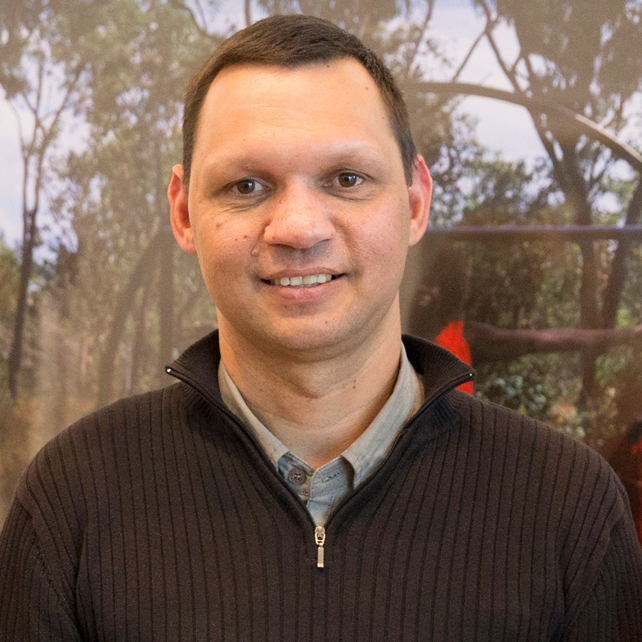
Darren Siwes
ALUMNI AWARD RECIPIENT 2019
Artist Darren Siwes’s birth in 1968 to a Dutch immigrant father and an Ngalkbun Aboriginal mother, catapulted him into a time of great political upheaval and social change in the late sixties.
Information correct at the time of receiving the award
At this stage in Australia’s history, the country’s counterculture and civil rights movements were in full swing, particularly for Aboriginal Australians, as the culturally explosive decade had already seen the Wave Hill Station walk off, the Freedom Rides, and the overwhelmingly positive 1967 Referendum results, mere months before his birth.
Darren describes growing up in such a politically-charged environment in which he struggled with a lot of denial of his own Aboriginal identity as “a tough time”. And while this meant his worldview was infused with his now signature political bite and social exploration, he found solace and catharsis in creative expression.
Dotted around his family home was the artwork of Darren’s Uncle Harold (Thomas), prominent land rights activist and the designer of the Aboriginal Flag.
“I was always astonished by my Uncle’s paintings. Absolutely astounded by them,” he recalls. “So those political issues, the Aboriginal flag and its inception, and its adoption into aboriginal culture, was something that was very influential in my life.”
Darren was given a pencil case at the age of five that set his life on an inspiring trajectory. The rest is history.
He defines his Visual Arts degree at the University of South Australia as a game-changer, as it was the first time he was provided an opportunity to really explore his identity and an immense freedom to understand his mother’s experiences as well.
Darren recalls his mother’s stories of her childhood as part of the stolen generation in Central Arnhem Land, hiding in caves while the roar of mission trucks looking for Aboriginal children rolled past, before actually picking her up and taking her to Croker Island.
“For me, looking at my mum’s identity and her upbringing was a major catalyst, giving me a really strong understanding about how much injustice was done and how that was important to me,” he says.
“With my socio-political background and also what I was studying, I had to do something, I couldn’t sit there and not create work about it.”
The conceptual and vast nature of Darren’s time at UniSA was also key in his discovery of photography, and what followed his Visual Arts degree and subsequent Graduate Diploma in Education, was a string of highly acclaimed and celebrated exhibitions of his work.
Each series of Darren’s work is a masterclass in the exploration of ‘space, place and identity’, racial tensions, and reality of the perceptions of Aboriginal people, thoroughly and painstakingly composed.
“With my socio-political background and also what I was studying, I had to do something, I couldn’t sit there and not create work about it.”
In 2004’s Misperceptions he explores the Indigenous presence on this land at contemporary sites of significance in Adelaide.
In 2008’s Oz Omnium Rex et Regina, Darren demonstrates how class delineations and our ingrained hierarchical systems could mean the difference between a mug shot or a head of state.
Similarly, his idea for 2006’s Mum, I want to be Brown – a series with his signature social dichotomy of themes featuring stunningly detailed hypothetical situations – was sparked after an illuminating conversation with his young son that challenged preconceived notions of identity.
Darren’s son Noah began to ponder the physical differences of his family as he got older growing up with a Caucasian mother and a father of Aboriginal descent.
“And it just led me to the whole idea around synaesthesia and kids just liking the colour brown, not really knowing or understanding the politics or the influence behind how society can shape ideas.”
“The whole body of work was about defiance. I’m not bound by this system.”
Darren’s ability to cut through these societal norms and positively influence a new generation of Aboriginal children has been an important driving factor throughout his career.
In addition to his illustrious art career, he has also taught for many years, including almost a decade at Tauondi College as a painting and drawing lecturer.
“I taught at Tauondi College for seven years and it was really all part of the foundation of my work, what my interests are, and where my passion lies – seeing Aboriginal people in Aboriginal communities thriving, and believing in themselves.”
He is creative to his core though.
“When I’m painting and when I’m drawing, that’s all I’m doing. That’s me at my most ease and most relaxed, natural state.”
“I’m at peace with myself, and who I am, when I am doing my art work.”




